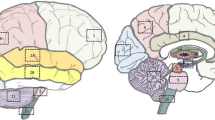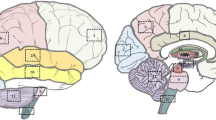Abstract
Trace elements and the relationships among them were investigated by direct chemical analysis in three basal ganglia regions in very old age individuals and age- and gender-related differences were assessed. After ordinary dissections at Nara Medical University were finished, the caudate nucleus, putamen, and globus pallidus belonging to the basal ganglia were removed from the identical cerebra of the subjects who consisted of 22 men and 23 women, ranging in age from 70 to 101 years (average age = 83.3 ± 7.5 years). After incineration with nitric acid and perchloric acid, the element contents were determined by inductively coupled plasma-atomic emission spectrometry. It was found that the Ca, P, and Mg contents increased significantly in the putamen with aging and the Mg content increased significantly in the globus pallidus with aging, but no elements increased significantly in the caudate nucleus with aging. Regarding the relationships among elements in the basal ganglia, extremely significant direct correlations were found among the Ca, P, and Mg contents in the putamen. These results suggested that slight calcification occurred in the putamen in very old age. With regard to seven elements of Ca, P, S, Mg, Zn, Fe, and Na, it was examined whether there were significant correlations among the caudate nucleus, putamen, and globus pallidus. It was found that there were extremely significant direct correlations among all of the three basal ganglia in the P content. Likewise, with regard to the Fe content, there were extremely or very significant direct correlations among all of the three basal ganglia. Regarding the gender difference in elements, it was found that the Ca content of the caudate nucleus was significantly higher in women than in men.







Similar content being viewed by others
References
Tohno S, Azuma C, Ongkana N et al (2008) Age-related changes of elements in human corpus callosum and relationships among these elements. Biol Trace Element Res 121:124–133
Ongkana N, Tohno S, Tohno Y et al (2010) Age-related changes of elements in the anterior commissures and the relationships among their elements. Biol Trace Element Res 135:86–97
Tohno Y, Tohno S, Ongkana N et al (2010) Age-related changes of elements and relationships among elements in human hippocampus, dentate gyrus, and fornix. Biol Trace Element Res 138:42–52
Ongkana N, Zhao X-Z, Tohno S et al (2007) High accumulation of calcium and phosphorus in the pineal bodies with aging. Biol Trace Element Res 119:120–127
Ke L, Tohno S, Tohno Y et al (2008) Age-related changes of elements in human olfactory bulbs and tracts and relationships among their contents. Biol Trace Element Res 126:65–75
Suwannahoy P, Tohno S, Mahakkanukrauh P et al (2010) Calcium increase in the mammillary bodies with aging. Biol Trace Element Res 135:56–66
Tohno S, Ishizaki T, Shida Y et al (2011) Element distribution in visual system, the optic chiasma, lateral geniculate body, and superior colliculus. Biol Trace Element Res 142:335–349
Tohno S, Ongkana N, Ke L et al (2010) Gender differences in elements of human anterior commissure and olfactory bulb and tract. Biol Trace Element Res 137:40–48
Tohno Y, Tohno S, Mahakkanukrauh P et al (2011) Gender differences in elements of the brain regions. In: Braissant O, Wakamatsu H, Kuo-Kang I et al (eds) Recent researches in modern medicine. WSEAS, Cambridge, pp 445–450
Hallgren B, Sourander P (1958) The effect of age on the non-haemin iron in the human brain. J Neurochem 3:41–51
Aquino D, Bizzi A, Grisoli M et al (2009) Age-related iron deposition in the basal ganglia: quantitative analysis in healthy subjects. Radiol 252:165–172
Bartzokis G, Tishler TA, Lu Po H et al (2007) Brain ferritin iron may influence age- and gender-related risks of neurodegeneration. Neurobiol Aging 28:414–423
Xu X, Wang Q, Zhang M (2008) Age, gender, and hemispheric differences in iron deposition in the human brain: an in vivo MRI study. NeuroImage 40:35–42
Cherubini A, Peran P, Caltagirone C et al (2009) Aging of subcortical nuclei: microstructural, mineralization and atrophy modifications measured in vivo using MRI. NeuroImage 48:29–36
Tohno Y, Tohno S, Matsumoto H et al (1985) A trial of introducing soft X-ray apparatus into dissection practice for students. J Nara Med Assoc 36:365–370
Tohno Y, Tohno S, Minami T et al (1996) Age-related changes of mineral contents in human thoracic aorta and in the cerebral artery. Biol Trace Element Res 54:23–31
Tohno Y, Tohno S, Moriwake Y et al (2001) Accumulation of calcium and phosphorus accompanied by increase of magnesium and decrease of sulfur in human arteries. Biol Trace Element Res 82:9–19
Tohno S, Tohno Y, Moriwake Y et al (2001) Quantitative changes of calcium, phosphorus, and magnesium in common iliac arteries with aging. Biol Trace Element Res 84:57–66
Tohno S, Tohno Y, Minami T et al (2002) Elements of calcified sites in human thoracic aorta. Biol Trace Element Res 86:23–30
Bigi A, Compostella L, Fichera AM et al (1988) Structural and chemical characterization of inorganic deposits in calcified human mitral valve. J Inorgan Biochem 34:75–82
Cohen CR, Duchesneau PM, Weinstein MA (1980) Calcification of the basal ganglia as visualized by computed tomography. Radiol 134:97–99
Vles JSH, Lodder J, Van der Lugt PJM (1981) Clinical significance of basal ganglia calcifications detected by CT (a retrospective study of 33 cases). Clin Neurol Neurosurg 83:253–256
Selekler K (1983) Calcification of the basal ganglia on computed tomography. Schweiz Arch Neurol Neurochir Psychiatr 131:187–195
Fenelon G, Gray F, Paillard F et al (1993) A prospective study of patients with CT detected pallidal calcifications. J Neurol Neurosurg Psychiatry 56:622–625
Wegiel J, Kuchna I, Wisniewski I et al (2002) Vascular fibrosis and calcification of the hippocampus in aging, Alzheimer disease and Down syndrome. Acta Neuropathol 103:333–343
Casanova MF, Araque JM (2003) Mineralization of the basal ganglia: implications for neuropsychiatry, pathology and neuroimaging. Psychiatr Res 121:59–87
Adachi M, Wellmann KF, Volk BW (1968) Histochemical studies of idiopathic non-arteriosclerotic cerebral calcification. J Neuropathol Exp Neurol 27:483–499
Slager UT, Wagner JA (1956) The incidence, composition and pathological significance of intracerebral vascular deposits in the basal ganglia. J Neuropathol Exp Neurol 15:417–431
Tohno Y, Tohno S, Ongkana N et al (2011) Relationships among the hippocampus, dentate gyrus, mammillary body, fornix, and anterior commissure from a viewpoint of elements. Biol Trace Element Res 140:35–52
Frausta da Silva JJR, Williams RJP (1991) The biological chemistry of the elements. Clarendon, Oxford
Oster O, Dahm M, Oelert H et al (1989) Concentrations of some trace elements (Se, Zn, Cu, Fe, Mg, K) in blood and heart tissue of patients with coronary heart disease. Clin Chem 35:851–856
Oster O, Dahm M, Oelert H (1993) Element concentrations (selenium, copper, zinc, iron, magnesium, potassium, phosphorous) in heart tissue of patients with coronary heart disease correlated with physiological parameters of the heart. Eur Heart J 14:770–774
Raz N, Rodrigue KM, Kennedy KM et al (2003) Differential aging of the human striatum: longitudinal evidence. Am J Neuroradiol 24:1849–1856
Gunning-Dixon FM, Head D, McQuain J et al (1998) Differential aging of the human striatum: a prospective MR imaging study. Am J Neuroradiol 19:1501–1507
Matochik JA, Chefer SI, Lane MA et al (2000) Age-related decline in striatal volume in monkeys as measured by magnetic resonance imaging. Neurobiol Aging 21:591–598
Laila Ahsan R, Allom R, Gousias IS et al (2007) Volumes, spatial extents and a probabilistic atlas of the human basal ganglia and thalamus. NeuroImage 38:261–270
Peran P, Cherubini A, Luccichenti G et al (2009) Volume and iron content in basal ganglia and thalamus. Human Brain Mapp 30:2667–2675
Connor JR, Menzies SL, St Martin SM et al (1990) Cellular distribution of transferrin, ferritin, and iron in the human brain. J Neurosci Res 27:595–611
Connor JR, Menzies SL (1996) Relationship of iron to oligodendrocytes and myelination. Glia 17:83–93
Benarroch EE (2009) Brain iron homeostasis and neurodegenerative disease. Neurol 72:1436–1440
Todorich B, Pasquini JM, Garcia CI et al (2009) Oligodendrocytes and myelination: the role of iron. Glia 57:467–478
Schipper HM (2012) Neurodegeneration with brain iron accumulation clinical syndromes and neuroimaging. Biochim Biophys Acta 1822:350–360
Cass WA, Grondin R, Andersen AH et al (2007) Iron accumulation in the striatum predicts aging-related decline in motor function in rhesus monkeys. Neurobiol Aging 28:258–271
Rajan MT, Jagannatha Rao KS, Mamatha BM et al (1997) Quantification of trace elements in normal human brain by inductively coupled plasma atomic emission spectrometry. J Neurol Sci 146:153–166
Riehemann S, Volz HP, Wenda B et al (1999) Frontal lobe in vivo (31) P-MRS reveals gender differences in healthy controls, not in schizophrenics. NMR Biomed 12:483–489
Author information
Authors and Affiliations
Corresponding author
Rights and permissions
About this article
Cite this article
Tohno, Y., Tohno, S., Azuma, C. et al. Mineral Composition of and the Relationships Between Them of Human Basal Ganglia in Very Old Age. Biol Trace Elem Res 151, 18–29 (2013). https://doi.org/10.1007/s12011-012-9535-1
Received:
Accepted:
Published:
Issue Date:
DOI: https://doi.org/10.1007/s12011-012-9535-1




